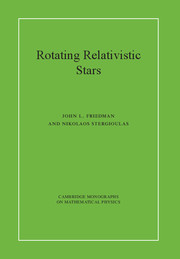Book contents
- Frontmatter
- Dedication
- Contents
- Preface
- List of symbols
- Conventions, notation, and mathematical preliminaries
- 1 Stationary, axisymmetric equilibria
- 2 3+1 split, action, Lagrangian, and Hamiltonian formalisms
- 3 Asymptotics, virial identities, and nonaxisymmetric equilibria
- 4 Numerical schemes
- 5 Equilibrium models
- 6 Approximation methods for equilibria
- 7 Perturbation theory of relativistic fluids
- 8 Quasinormal modes
- 9 Stellar stability
- 10 Nonlinear dynamics of rotating relativistic stars
- Appendix A Lie derivatives, forms, densities, and integration
- Appendix B The Newtonian limit of the two-potential formalism
- Bibliography
- Index
1 - Stationary, axisymmetric equilibria
Published online by Cambridge University Press: 05 July 2013
- Frontmatter
- Dedication
- Contents
- Preface
- List of symbols
- Conventions, notation, and mathematical preliminaries
- 1 Stationary, axisymmetric equilibria
- 2 3+1 split, action, Lagrangian, and Hamiltonian formalisms
- 3 Asymptotics, virial identities, and nonaxisymmetric equilibria
- 4 Numerical schemes
- 5 Equilibrium models
- 6 Approximation methods for equilibria
- 7 Perturbation theory of relativistic fluids
- 8 Quasinormal modes
- 9 Stellar stability
- 10 Nonlinear dynamics of rotating relativistic stars
- Appendix A Lie derivatives, forms, densities, and integration
- Appendix B The Newtonian limit of the two-potential formalism
- Bibliography
- Index
Summary
The Newtonian approximation describes to extraordinarily high precision the gravitational field of low-mass stars over the course of their evolution, from the instability to collapse that triggers their formation to their death as white dwarfs. In a high-mass star, however, when the nuclear reactions that halted its initial collapse ultimately die out, the core's renewed collapse leads either to a star above nuclear density or to a black hole at whose center is a speck that, at least momentarily, is vastly beyond any known density. In both of these final states of stellar evolution, general relativity plays a fundamental role. The relativistic stars of nature have a complex composition, spanning fifteen orders of magnitude in density. Thought to consist primarily of a gas of neutrons with a gradually varying density of free protons, electrons, and muons, they are surrounded by a crust of ordinary matter, and their cores may hold hyperons, pion or kaon condensates, or possibly free quarks. In fact, our uncertainty about the behavior of matter above nuclear density is (in 2012) great enough to allow what we call neutron stars to be strange-quark stars, collections of up, down, and strange quarks surrounded by a thin normal crust. In the conventional neutron-star model, a much thicker, 1-km crust surrounds an interior in which neutrons and protons form a two-component superfluid.
- Type
- Chapter
- Information
- Rotating Relativistic Stars , pp. 1 - 30Publisher: Cambridge University PressPrint publication year: 2013



